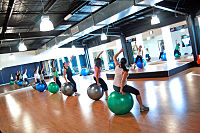
Photo from wikipedia
Background: In proprioceptive training, unstable devices produce multidirectional perturbations that must be counterbalanced by the postural control systems and core-muscle activation. We investigated whether different sizes and shapes of three… Click to show full abstract
Background: In proprioceptive training, unstable devices produce multidirectional perturbations that must be counterbalanced by the postural control systems and core-muscle activation. We investigated whether different sizes and shapes of three gymnastic balls could affect core-muscle activation and postural balance when performing the same exercise. Methods: Eleven young healthy subjects were assessed on the balls, assuming two body postures (bipedal seated and unipedal seated) and performing a dynamic exercise. Two balls were spherical with different diameters, and one was ovoid. Postural balance and muscle activation were assessed through center of pressure (CoP)-related parameters and surface electromyography. Results: Statistical analysis showed a significant effect of the gymnastic balls (p < 0.001) and the body postures (p < 0.001) for the CoP-related parameters, with the ovoid shape and the bipedal sitting representing the easiest conditions. Core-muscle activation was affected only by body postures, with a higher activation in the unipedal sitting (p < 0.01). In the dynamic exercise, significant differences were only detected for the CoP-related parameters (p < 0.001). Conclusions: The shapes and sizes of the gymnastic balls produced different degrees of destabilization under the same body posture but left the core-muscle activation unaltered. In the dynamic exercise, the conformation of the balls did not represent the main determinant in producing destabilizing effects.
Journal Title: Applied Sciences
Year Published: 2021
Link to full text (if available)
Share on Social Media: Sign Up to like & get
recommendations!